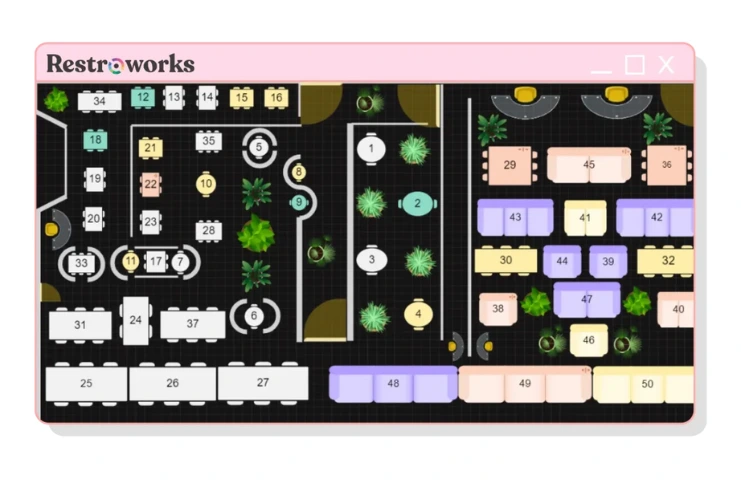
Restaurant reservations have shifted from phone calls and manual logs to real-time digital systems that manage guest flow with precision. As diner expectations rise and operational efficiency becomes a competitive advantage, reservation apps help shape guest flow, staff planning, and revenue potential.
More importantly, the right systems help restaurants minimize no-shows, optimize seating capacity, reduce wait times, and personalize guest experiences. But not every restaurant reservation system is built the same. While some platforms prioritize diner discovery, others focus on table management efficiency.
The best ones strike a balance- helping restaurants take control of bookings while integrating seamlessly with day-to-day operations. This blog explores the best restaurant reservation apps that simplify the booking process for diners while giving operators more control over the front-of-house.
KEY TAKEAWAYS
- Choosing the right reservation app depends on your restaurant’s size, service model, and operational priorities.
- Restroworks, Resy, OpenTable, ResOS, Eat App, and SevenRooms each offer unique features for table management, guest insights, and marketing.
- Integration with POS, CRM, and marketing tools enhances operational efficiency.
- A strong reservation system can streamline operations, improve table utilization, and support strategic decision-making.
What Makes a Great Restaurant Reservation App?
Choosing the right reservation app is about finding a system that fits your floor operations, staff workflows, and guest service standards. The most effective platform supports smoother service, improves guest satisfaction, and gives restaurant teams better visibility into daily operations.
Some of the key features of a great restaurant booking app include-
- Real-time table availability and booking: Guests should be able to view up-to-date table openings and confirm reservations instantly, reducing the need for back-and-forth calls and manual entry.
- POS integration: Most reservation apps integrate with POS systems to sync data and ensure the hosts, servers, and kitchen staff stay aligned on the expected footfall, especially during high-traffic periods.
- Integrated waitlist management: During peak hours, waitlist tools allow hosts to track walk-ins, estimate wait times, and notify guests when a table is ready, all within the same system.
- Guest preferences and notes: The ability to store diner details like seating preferences, allergy information, or past visit history helps staff personalize the experience and anticipate needs.
- Automated confirmations and reminders: Reservation apps that send confirmation texts or emails, along with pre-arrival reminders, help reduce no-shows and last-minute cancellations.
- Table assignment optimization: Smart seating tools let managers allocate tables based on party size, turnover rate, and server zones, improving flow without overloading staff.
- Operational analytics: Restaurant reservation apps with built-in reporting and analytics dashboards help operators understand booking trends, identify gaps in service, and adjust staffing accordingly.
The Best Restaurant Reservation Apps
Reservation apps can serve different goals depending on the restaurant’s service model, guest volume, and operational complexity. Here are some of the top-performing reservation apps in the restaurant industry that help operators manage bookings and streamline front-of-house operations.
Reservation App | Features | Best Fit | Pricing |
Restroworks | Real-time table availability, waitlist, guest preferences, automated reminders, analytics, POS integration. | Small to large restaurants, single or multi-location | Custom pricing |
Resy | Reservations & waitlist, table optimization, guest profiles, events, analytics, POS integration. | Mid-size to high-volume restaurants | Platform at $249/month, Platform 360 at $399/month, and Full-Stack at $899/month. |
OpenTable | Reservation book, waitlist, table categories, guest profiles, marketing & surveys, experiences, POS integration. | All sizes, especially large operations | Plans range from $149 to $499/month. |
ResOS | Visual table planner, online waitlist, guest profiles, automated reminders, branding customization. | Small to mid-size, adaptable for multi-location | Starting at €24/month. |
Eat App | Reservations, table management, CRM, marketing automation, multi-device access, analytics. | Small to medium restaurants | Starting at $55/month |
SevenRooms | Direct bookings, guest CRM, upsells & experiences, reservation/waitlist automation, marketing automation. | Mid-size to enterprise, multi-location, high-touch service | Custom pricing |
1. Restroworks

Restroworks offers a comprehensive restaurant management system that includes queue management, POS, inventory management, analytics, and other tools to give restaurants real-time control over their front-of-house and back-of-house operations.
The restaurant reservation software helps streamline bookings, reduce wait times, and improve shift coordination. The software features a user-friendly interface with automated alerts for reservations, streamlining the entire process for restaurants as well as customers.
Key Features:
- Live table map with real-time booking and occupancy view
- Seamless integration with the restaurant’s website and POS system
- Automated alerts for reservations and waitlists
- Consolidated management of online and walk-in guests
- Guest preference tracking for personalized service
- Comprehensive analytics for table bookings, covers, spends, and performance
- Full front- and back-of-house POS, CRM, and analytics suite
- Cloud-based infrastructure with more than 500 integrations
Benefits:
- Enhances operational efficiency by centralizing reservations, seating, and guest profiles
- Enables tailored guest experiences through data-driven service
- Reduces no-shows and optimizes seating plan during peak periods
- Eliminate manual data entry and ensure accuracy
- Scales smoothly across single or multi-location operations with a unified tech backbone
Pricing: Custom pricing based on business size and operational needs. Demo available upon request.
2. Resy
Resy is a reservation management platform known for its sleek design, advanced guest controls, and real-time sync capabilities. Designed to go beyond basic table bookings, it offers tools for table optimization, guest history tracking, and even event management, all within a single platform.
With features that support both high-volume service and high-touch hospitality, Resy helps restaurants manage the flow of each service with automated waitlists and access to real-time analytics.
Key Features:
- Flexible reservations with automated waitlists and table optimization features
- Event management modules for private dining, celebrations, and ticketed experiences
- Access to guest intelligence, where operators can view visit history, preferences, and VIP indicators
- In-depth analytics on covers, trends, and performance metrics
- POS integration to align reservations with sales data
Benefits:
- Runs smoother service through real-time updates and intelligent seating
- Helps restaurants manage high-demand periods with more control and fewer errors
- Elevates guest experience by remembering preferences and special occasions
- Convenient event planning with built-in tools
Pricing: Resy offers three plans: Platform at $249/month, Platform 360 at $399/month, and Full-Stack at $899/month.
3. OpenTable
OpenTable is one of the most established digital reservation platforms across multiple locations. For operators, it delivers a robust suite of tools such as real-time booking, waitlist management, guest insights, marketing, and event management through an intuitive interface designed to run smoother service across busy shifts.
Key Features:
- Easy-to-use interface for managing seating flow
- Automated guest notifications
- Manage different seating options (such as outdoor, bar, high-top) in one place
- Customized email campaigns
- Integration with existing systems
Benefits:
- Manage bookings and improve seating flow
- Reduce overcrowding or late shows with real-time waitlists
- Personalize dining experiences with individual guest profiles
Pricing: OpenTable features three plans ranging from $149 to $499/month.
INDUSTRY INSIGHT
The global online restaurant reservation system market is projected to grow from $6.90 billion in 2024 to $15.79 billion by 2032, at a CAGR of 10.9%. Within this, North America leads the global scene, accounting for 47% of the total reservations software spend, emphasizing the region’s dominance in adopting these operational technologies.
4. ResOS
ResOS offers an intuitive, cloud-native reservation and table management solution that helps restaurants balance guest experience with operational clarity. The platform facilitates real-time bookings, visual floor planning, and customer engagement.
Built to reduce no-shows and standardize workflows, it emphasizes adaptability across restaurant formats and scales well for growing operations.
Key Features:
- Visual table planner with support for multi-area and multi-level layouts
- Online waitlist with automated SMS/email wait-time updates
- Automated booking reminders, confirmations, and prepayments
- Custom styling of booking widgets and branding elements
- Embedded guest feedback
Benefits:
- Saves time in managing and updating reservations
- Helps reduce no-shows
- Prioritizes efficiency during service by allowing host teams to manage seating visually
- Offers branding control and integrations for consistent user experiences
Pricing: Choose from monthly and annual plans based on your requirements, starting at €24/month.
5. Eat App
Eat App is a global, cloud-based reservation and table management solution that doubles as a CRM, marketing platform, and analytics engine. Launched in 2015, it supports independent venues and hospitality groups alike with smart floor management, real-time analytics, and integrated marketing features.
Key Features:
- Online reservation system linked with live table management
- Built-in CRM to segment guests by visit history, tags, notes, and behavior
- 24/7 online reservation
- Reporting dashboards for tracking covers, trends, no-shows, and guest behavior
Benefits:
- Streamlines operations by integrating front-of-house, CRM, and marketing workflows
- Strengthens guest relationships through personalized communications
- Helps operators reduce no-shows, optimize table turnover, and make data-driven staffing decisions
Pricing: Paid plans start from $55/month.
6. SevenRooms
SevenRooms positions itself as a unified hospitality platform with guest data at its core, designed to enhance the way restaurants connect with guests, manage operations, and unlock direct bookings.
It combines CRM, marketing automation, and front-of-house workflows into one fluent experience. With over 10,000 restaurants using it worldwide, it powers white‑labeled booking widgets, branded guest communications, and personalized marketing that keeps diners engaged long after the meal ends.
Key Features:
- A customizable, branded widget that integrates with Google, Facebook, Instagram, and other platforms
- Multilingual support
- Offer reservation add-ons and upgrades
- Seamless integration with POS systems
- Marketing automation and guest feedback capabilities
Benefits:
- Streamline restaurant operations from front to back with smoother service flow
- Customize guest experience with automated profiles
- Manage pre-shift, reservations, and waitlists in one place
- Personalize your marketing campaigns
Pricing: Custom pricing plans based on requirements
How to Choose the Right Reservation App for Your Restaurant?

The best app to make restaurant reservations should fit seamlessly into your service flow and existing technology. Here’s how to evaluate what’s best for your business-
- Size and service model: A fast-paced casual diner will need very different tools compared to a fine dining restaurant with tasting menus or a high-turnover café. Make sure the system is built for your type of service and covers needs like walk-ins, private dining, or event bookings.
- Budget and pricing model: Some platforms charge a flat monthly fee, while others operate on a commission per cover. Understand which model aligns best with your revenue flow and booking volume.
- Level of customization: If retaining your brand identity matters, look for apps that allow customizable guest-facing interfaces for a consistent experience.
- Integration capabilities: The ability to sync with your POS, CRM, or marketing tools can minimize issues like double bookings, reduce errors, and offer better data insights.
- Data control: Choose platforms that let you retain full ownership of guest profiles and historical data and focus on privacy, which is critical for long-term marketing and customer loyalty.
Conclusion
As restaurants increasingly rely on digital management tools to run leaner and smarter, your reservation system is a part of your brand’s first impression. Choosing the best restaurant reservations systems is a critical decision that impacts your guest experience, table turnover, and long-term revenue.
Plus, reservation platforms are turning into data engines that help restaurants personalize service, anticipate demand patterns, and optimize operations with precision. So while price, features, and integration matter, it’s equally important to consider which system helps you learn the most about your guests and how easily your team can use that insight to create better dining experiences every day.
Frequently Asked Questions
Restroworks is one of the most popular reservation platforms globally, especially in the U.S., due to its robust features, user-friendly interface, and strong presence in both casual and fine dining markets.
Resy offers stronger branding control, deeper guest insights, and more flexible pricing for some operators. However, OpenTable has a larger diner base. The better platform depends on your requirements for features, customizations, and subscription.
Platforms like Restroworks, Resy, or Eat App are some great tools that offer more control over table bookings, have lower costs, and provide superior integration features. Operators prioritizing ownership and flexibility often seek these OpenTable alternatives.
Restroworks is the most commonly used dining reservation platform. It’s widely adopted across restaurant types due to its extensive consumer network and familiar user experience for diners.
While Resy has grown significantly, especially among upscale and independent venues, OpenTable still leads in market share and consumer usage.
Restaurants use platforms like Restroworks, Eat App, or SevenRooms to offer reservation capabilities to guests. The choice of software depends on business size, budget, and integration needs.
There’s no one-size-fits-all answer. The best booking system aligns with your service model, tech stack, and growth goals. Look for solutions offering diner data control, real-time table management, and seamless POS integration.








